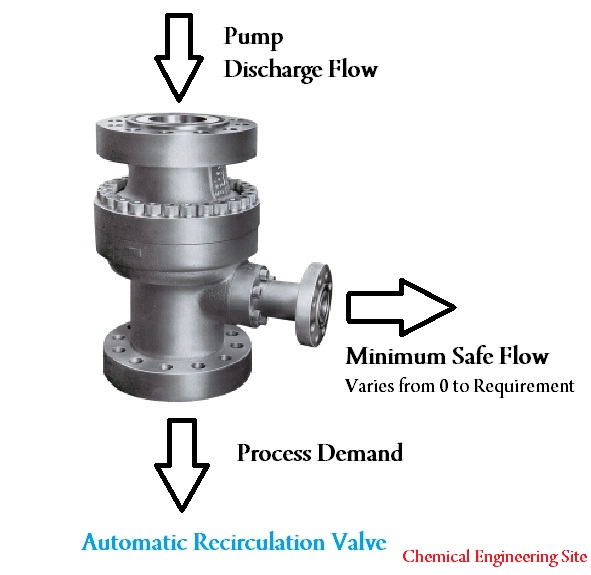What is Minimum Thermal Flow in Centrifugal Pumps?
Minimum Thermal Flow in Centrifugal Pump is defined as, “The lowest flow at which the pump can operate without its operation being impaired by the temperature rise o f the pumped liquid”
The temperature of the liquid in the pump casing is to be kept below the saturation temperature of the liquid. The overheating of the liquid inside the centrifugal pump casing may occur because of two ways. First is Recirculation of liquid inside the casing and the second way is Energy from Driver Equipment is converted to heat and it raises the temperature of liquid inside the pump.
If the temperature of the liquid inside the pump casing increases beyond the saturation temperature, liquid starts to vaporize and results in cavitation of the pump.
Effects of Minimum Safe Flow:
If the Minimum flow through centrifugal pump is not ensured it may result in any one of the following.
Mechanical Damage due to Overheating
Cavitation and Vibration due to recirculation of liquid inside the casing
Mechanical Seal and Bearing Failure
Catastrophic failure due to hazardous liquid explosion/fire
How to Maintain Minimum Thermal Flow in Centrifugal Pumps?
The minimum flow operation in centrifugal pumps may arise during the situations of low load operations and during the start up and shutdown of the process plants. The methods of maintaining minimum thermal flow in centrifugal pumps are as follows.
1. Spill back Flow through Restriction Orifice
2. Control Valves
a) Trip Valve in Spill Back line
b) Split Range Control Valves in Discharge and Spill back lines
c) Pressure Control Valve in Spill back line
3. Automatic Recirculation Valves in Discharge
Spill back Flow through Restriction Orifice
Recycle flow using restriction orifice in spill back line maintains the continuous minimum thermal flow. Simple and highly reliable system. Lower investment Cost. Continuous recycle flow result in waste of energy when the centrifugal pumps operate above the minimum flow and process requirement may not be adequate for higher loads of the plant.
Control Valves for Minimum Thermal Flow
a) Trip Valve in Spill Back line – To be actuated sensing the low flow in the pump discharge to recycle the flow through spill back. Resets and Control valve gets closed when the Process demand exceeds the minimum thermal flow of the Centrifugal pumps
b) Split Range Control Valves in Discharge and Spill back lines – Discharge and Spill back lines are equipped with Split range Control valves. The control valve in the discharge line will cater the process requirement and if it becomes less than the minimum safe flow the control valve in the spill back line recycles the flow and protects the pump
c) Pressure Control Valve in Spill back line – When the discharge pressure increases due to low process demand, the pressure control valve gets opened and reduces the pressure to the required value.
The above system requires Controllers and Control valves to be installed. Operating cost is required for both power and Instrument air. The control valves are not most commonly used for ensuring the minimum safe flow requirements of the centrifugal pump because of high capital cost.
Automatic Recirculation Valves (ARC)

Automatic Recirculation valves (ARC) or Minimum Flow Check Valves (MFCV) are spring loaded recirculation valves. It re circulates the only the minimum flow required to operate the pump and if pump flow for process demand is more than the minimum thermal flow the recirculation port closes automatically and recirculation flow becomes zero. It eliminates the higher capital cost required for installation of control valves. The pump and driver need not be oversized to take care of minimum pump flow since recirculation flow can be made zero during high process demands.
Buy Related Books:
PERRY’S CHEMICAL ENGINEERS’ HANDBOOK,8/ED from Flipkart.com